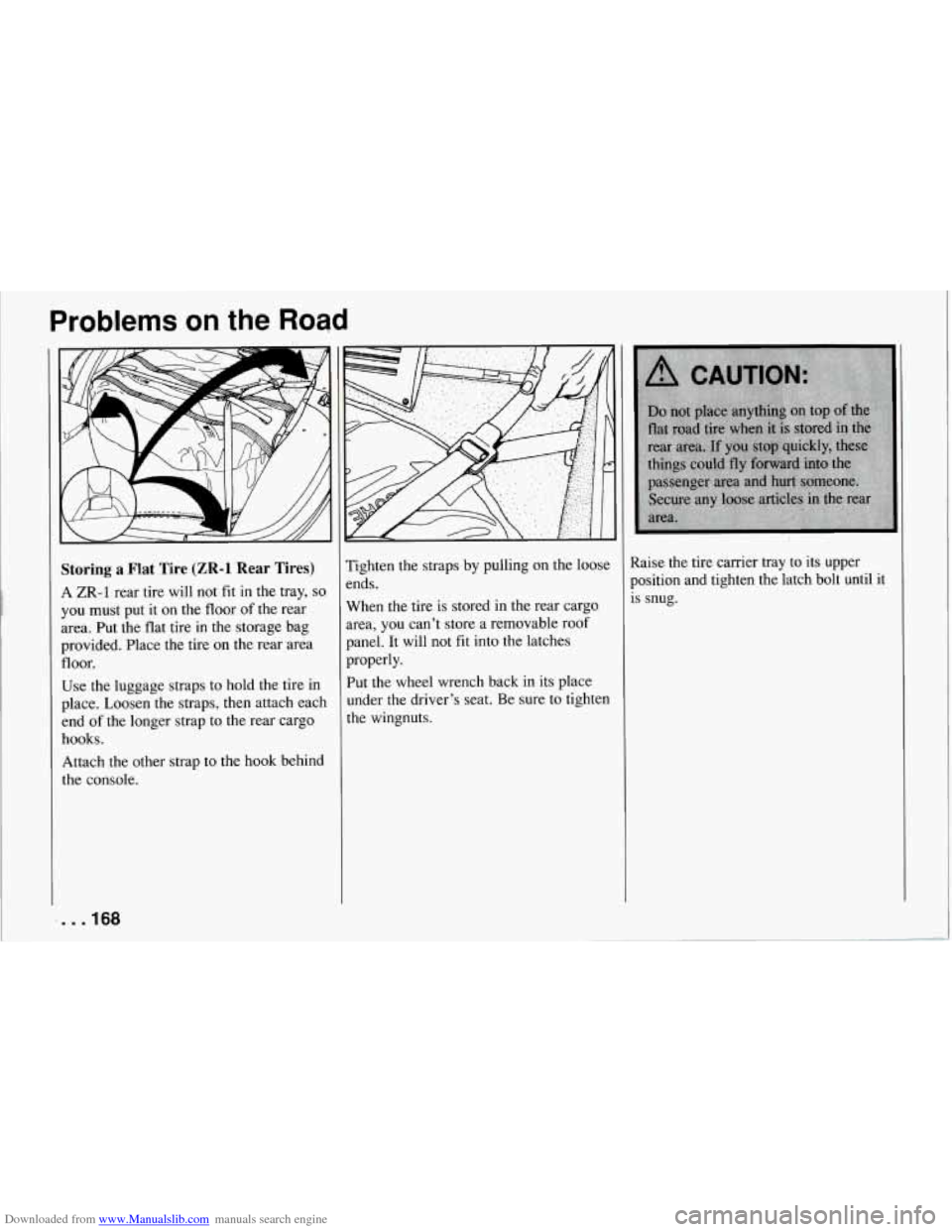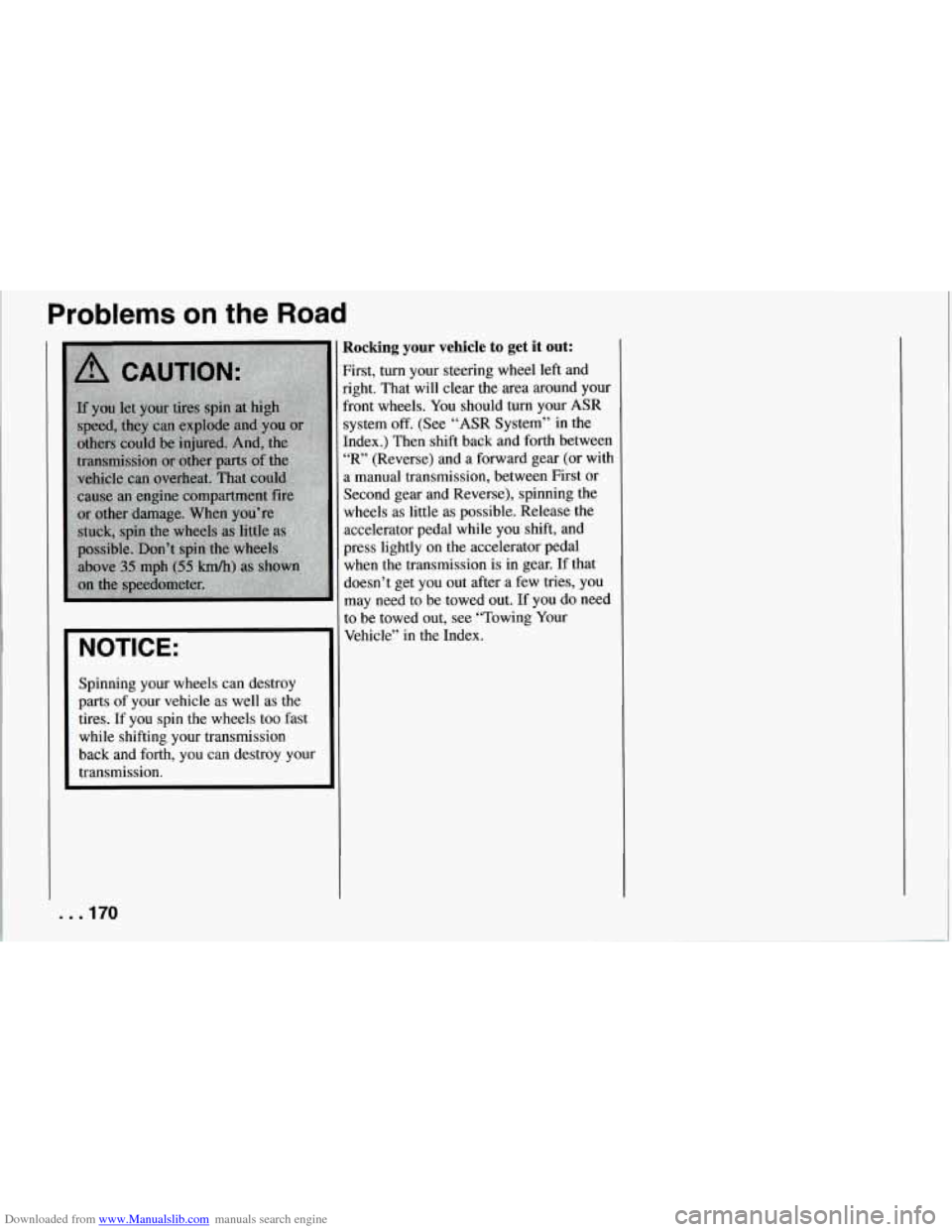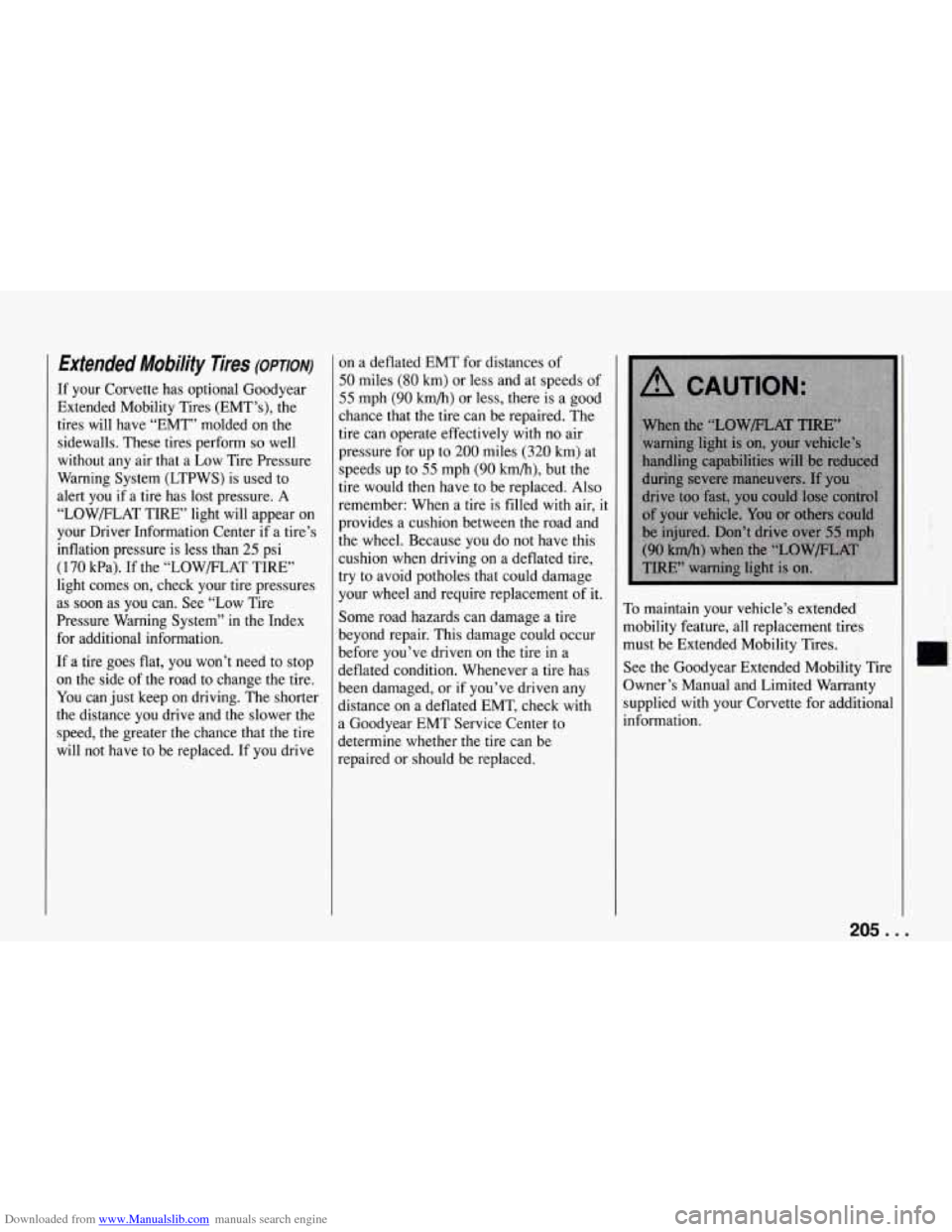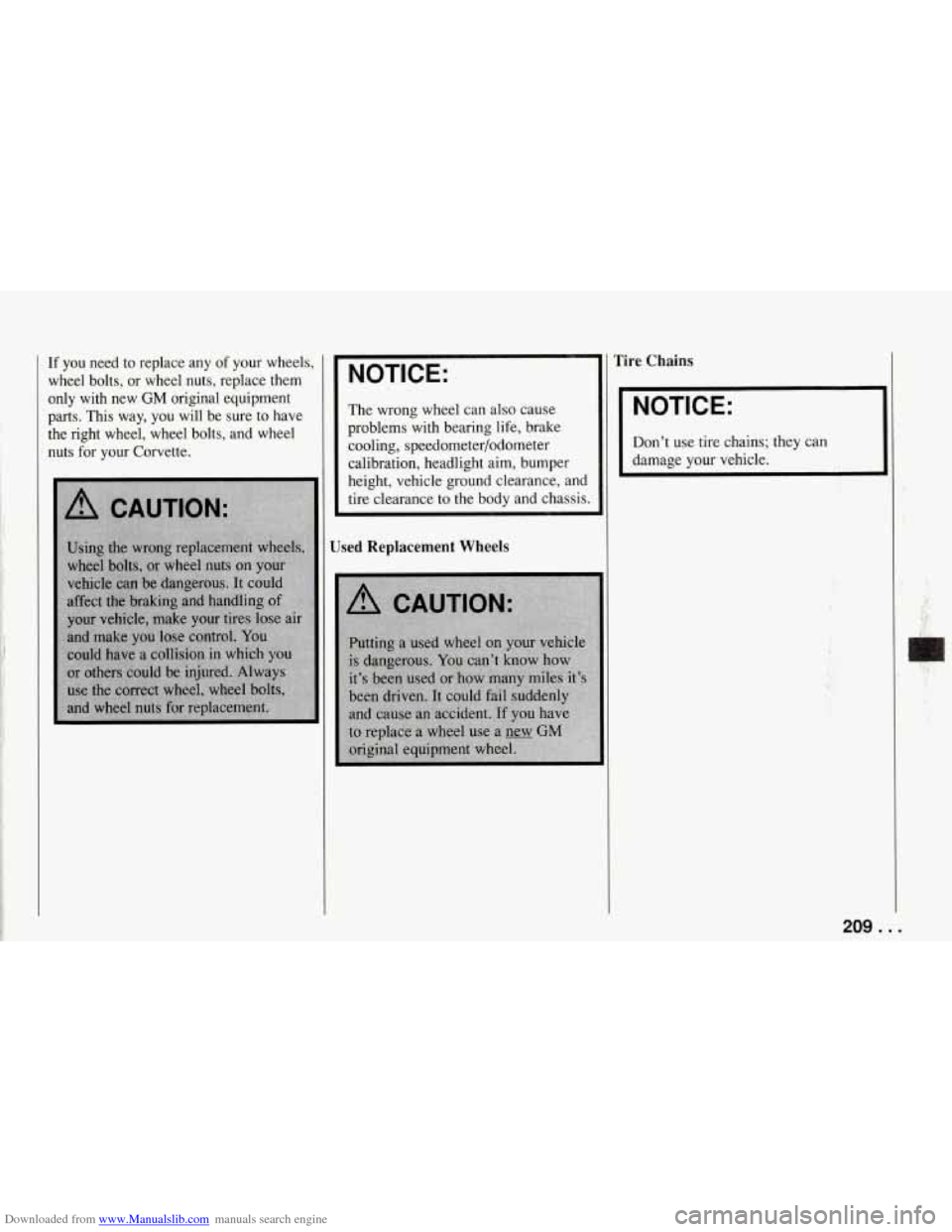1994 CHEVROLET CORVETTE wheel
[x] Cancel search: wheelPage 169 of 274

Downloaded from www.Manualslib.com manuals search engine Problems on the Road
Storing a Flat Tire (ZR-1 Rear Tires)
A ZR-1 rear tire will not fit in the tray, so
you must put it on the floor of the rear
area. Put the flat tire
in the storage bag
provided. Place the tire on the rear area
floor.
Use the luggage straps to hold the tire in
place. Loosen the straps, then attach each
end of the longer strap to the rear cargo
hooks.
Attach the other strap to the hook behind
the console. righten
the straps by pulling
on the loose
ends.
When the tire is stored in the rear cargo
area, you can’t store a removable roof
panel. It will not
fit into the latches
properly.
Put the wheel wrench back in its place
under
the driver’s seat. Be sure to tighten
the wingnuts. Raise the
tire carrier tray to its upper
position and tighten the latch bolt until
it
is snug.
Page 170 of 274

Downloaded from www.Manualslib.com manuals search engine Compact Spare Tire
Although the compact spare was fully
inflated when your vehicle was new, it
can lose air after a time. Check the
inflation pressure regularly. It should be
60 psi (420 kPa). After installing the
compact spare on your vehicle, you
should stop as soon as possible and make
sure your spare tire is correctly inflated.
The compact spare is made to perform
well at posted speed limits for distances
up to
3,000 miles (5 000 km), so you can
finish your trip and have your full-size
tire repaired or replaced where you want.
Of course, it’s best to replace your spare
with a full-size tire as soon as you can.
Your spare will last longer and be in
good shape in case you need it again.
-
NOTICE:
Don’t take your compact spare
through an automatic car wash with
guide rails. The compact spare can
get caught on the rails. That can
damage the tire and wheel, and
maybe other parts
of your vehicle.
Don’t use your compact spare on some
other vehicle.
And don’t
mix your compact spare or
wheel with other wheels
or tires. They
won’t
fit. Keep your spare and its wheel
together.
NOTICE:
Tire chains won’t fit your compact
spare. Using them will damage
your vehicle and destroy the chains
too. Don’t use tire chains on your
compact spare.
If You’re Stuck: In
Sand, Mud, Ice or
Snow
What you don’t want to do when your
vehicle is stuck is to spin your wheels.
The method known as “rocking” can help
you get out when you’re stuck, but .you
must use caution.
169 ...
Page 171 of 274

Downloaded from www.Manualslib.com manuals search engine Problems on the Road
NOTICE:
Spinning your wheels can destroy
parts of your vehicle as well as the
tires. If you spin the wheels too fast
while shifting your transmission
back and forth, you can destroy your
transmission.
. . .I70
Rocking your vehicle to get it out:
First, turn your steering wheel left and
ight. That will clear the area around your
front wheels. You should
turn your ASR
system
off. (See “ASR System” in the
[ndex.) Then shift back and forth between
“R’ (Reverse) and a forward gear (or with
9 manual transmission, between First or
Second gear and Reverse), spinning the
wheels as little as possible. Release the
accelerator pedal while you shift, and
press lightly on the accelerator pedal
when the transmission is in gear. If that
doesn’t get you out after a few tries, you
may need to be towed out.
If you do need
to be towed out, see “Towing Your
Vehicle” in the Index.
Page 195 of 274

Downloaded from www.Manualslib.com manuals search engine Service and Appearance Care
NOTICE:
Don’t let someone put in the
wrong kind of fluid. For example,
just a few drops of mineral-based
oil, such as engine oil, in your
brake system can damage brake
system parts
so badly that they’ll
have to be replaced.
Brake fluid can damage paint,
so
be careful not to spill brake fluid
on your vehicle. If you
do, wash it
off immediately. See “Appearance
Care” in the Index.
Brake Wear
Your Corvette has four-wheel disc brakes.
Disc brake pads have built-in wear
indicators that make a high-pitched
warning sound when the brake pads are
worn and new pads are needed. The
sound may come and go or be heard all
the time your vehicle is moving (except
when you are pushing
on the brake pedal
firmly).
I NOTICE:
I
Continuing to drive with worn-out
brake pads could result in costly brake repair.
Some driving conditions or climates may
cause a brake squeal when the brakes are
first applied or lightly applied. This does not mean something is wrong with your
brakes. Brake linings should always be
replaced as complete axle sets.
Brake Pedal Travel
See your dealer if the brake pedal does
not return to normal height, or if there is
a rapid increase in pedal travel. This
could be a sign of brake trouble.
Brake Adjustment
As you make brake stops, your disc
brakes automatically adjust for wear.
Replacing Brake System Parts
The braking system on a modern vehicle
is complex. Its many parts have to be of
top quality and work well together
if the
vehicle is to have really good braking.
Vehicles we design and test have
top-quality GM brake parts in them, as
your Corvette does when it is new. When
you replace parts of your braking system
- for example, when your brake linings
wear down and you have to have new
ones put in
- be sure you get new
genuine GM replacement parts. If you
don’t, your brakes may no longer work
properly. For example,
if someone puts
in brake linings that are wrong for your
vehicle, the balance between your front
and rear brakes can change, for the worse. The braking performance you’ve come to
expect can change in many other ways
if
someone puts in the wrong replacement
brake parts.
. . .I94
Page 206 of 274

Downloaded from www.Manualslib.com manuals search engine Extended Mobility Tires (omoiv)
If your Corvette has optional Goodyear
Extended Mobility Tires (EMT’s), the tires will have “EMT” molded on the
sidewalls. These tires perform
so well
without any air that a Low Tire Pressure
Warning System (LTPWS)
is used to
alert you if a tire has lost pressure.
A
“LOWELAT TIRE” light will appear on
your Driver Information Center if a tire’s
inflation pressure is less than
25 psi
(1 70 kPa). If the “LOWELAT TIRE”
light comes on, check your tire pressures
as soon as you can. See “Low Tire
Pressure Warning System” in
the Index
for additional information.
If a tire goes flat, you won’t need to stop
on the side of the road to change the tire.
You can just keep on driving. The shorter
the distance you drive and the slower the
speed, the greater the chance that the tire
will not have to be replaced. If you drive on
a deflated EMT for distances
of
50 miles (80 km) or less and at speeds of
55 mph (90 km/h) or less, there is a good
chance that the tire can be repaired. The
tire can operate effectively with no air
pressure for up to
200 miles (320 km) at
speeds up to
55 mph (90 km/h), but the
tire would then have to be replaced. Also
remember: When a tire is filled with air, it
provides a cushion between the road and
the wheel. Because you do not have this
cushion when driving on a deflated tire,
try to avoid potholes that could damage
your wheel and require replacement of it.
Some road hazards can damage a tire
beyond repair. This damage could occur
before you’ve driven on the tire in a
deflated condition. Whenever a tire has
been damaged, or if you’ve driven any
distance on a deflated EMT, check with
a Goodyear EMT Service Center to
determine whether the tire can be
repaired or should be replaced. To
maintain your vehicle’s extended
mobility feature, all replacement tires
must be Extended Mobility Tires.
See the Goodyear Extended Mobility Tire
Owner’s Manual and Limited Warranty
supplied with your Corvette for additional
information.
205. .
Page 207 of 274

Downloaded from www.Manualslib.com manuals search engine Service and Appearance Care
Inflation - Tire Pressure
The Tire-Loading Information label which is on the driver’s door shows the correct
inflation pressures for your tires, when they’re cold. “Cold” means your vehicle has
been sitting for at least three hours or driven no more than a mile.
For competitive driving or high-speed driving (over
150 mph or 240 krn/h), make
sure your tires are inflated to
35 psi (240 kPa). When you end this type of driving,
reduce the “cold” inflation pressures (if necessary) to those listed
on the
Tire-Loading Information label.
NOTICE:
Don’t let anyone tell you that underinflation or overinflation is all right. It’s not.
If your tires don’t have enough air (underinflation) you can get:
0 Too much flexing
0 Too much heat
0 Tire overloading
0 Bad wear
0 Bad handling
Bad fuel economy.
If your tires have too much air (overinflation), you can get:
Unusual wear
Bad handling
0 Rough ride
Needless damage from road hazards.
When to Check: Check your tires
mce
a month or more. Don’t forget
your compact spare tire. It should be at
50 psi (420 Wa).
How to Check: Use a good quality
pocket-type gauge to check tire
pressure. Simply looking at the tires
will not tell you the pressure,
=specially if you have radial tires
-
which may look properly inflated even
if they’re underinflated.
Lf your tires have valve caps, be sure to
put them back on. They help prevent
leaks by keeping out dirt and moisture.
Tire Rotation
I’he tires on your Corvette are
lirectional, asymmetrical, and are
different sizes front to rear. Due to this,
your tires should not be rotated. Each
tire and wheel should be used only in
the position it is in.
. . .206
Page 209 of 274

Downloaded from www.Manualslib.com manuals search engine Service and Appearance Care
on a specified government test course. For
example, a tire graded 150 would wear
one and a half
(1 1/2) times as well on the
government course as a tire graded
100.
The relative performance of tires depends
upon the actual conditions of their use,
however, and may depart significantly
from the norm due to variations in driving
habits, service practices and differences in
road characteristics and climate.
Traction - A, B, C
The traction grades, from highest to
iowest are:
A, B, and C. They represent
the tire’s ability to stop on wet pavement
as measured under controlled conditions
on specified government test surfaces of
asphalt and concrete.
A tire marked C
may have poor traction performance.
Warning: The traction grade assigned
to this tire is based on braking
(straight-ahead) traction tests and does
not include cornering (turning) traction.
Temperature - A, B, C
The temperature grades are A (the
highest),
B, and C, representing the tire’s
resistance to the generation of heat and its
ability to dissipate heat when tested under
controlled conditions on a specified
. . .208
indoor laboratory test wheel. Sustained
high temperature can cause the material
of the tire to degenerate and reduce tire
life, and excessive temperature can lead to
sudden tire failure. The grade C
corresponds to a level
of performance
which all passenger car tires must meet
under the Federal Motor Vehicle Safety
Standard
No. 109. Grades B and A
represent higher levels of performance on
the laboratory test wheel than the
minimum required by law.
Warning: The temperature grade for
this tire is established for a tire that is
properly inflated and not overloaded.
Excessive speed, underinflation, or
excessive loading, either separately or
in combination, can cause heat buiidup
and possible tire failure.
These grades are molded on the sidewalls
of passenger car tires.
While the tires available as standard or
optional equipment on General Motors
vehicles may vary with respect to these
grades, all such tires meet General Motors
performance standards and have been
approved for use on General Motors
vehicles. All passenger type
(P Metric)
tires must conform to Federal safety
requirements in addition to these grades.
Wheel Alignment and Tire Balance
The wheels on your vehicle were aligned
and balanced carefully at the factory to
give you the longest tire life and best
overall performance.
In most cases, you will not need to have
your wheels aligned again. However, if
you notice unusual tire wear or your
vehicle pulling one way or
the other, the
alignment may need to be reset. If you
notice your vehicle vibrating when
driving on a smooth road, your wheels may need to be rebalanced.
Wheel- Replacement - . -
Replace any wheel that is bent, cracked or
badly rusted. If wheel nuts keep coming
loose, the wheel, wheel bolts, and wheel
nuts should be replaced. If the wheel
leaks air, replace it (except some
aluminum wheels, which can sometimes
be repaired). See your Chevrolet dealer
if any of these conditions exist.
Your dealer will know the kind of wheel
you need.
Each new wheel should have the same
load carrying capacity, diameter, width,
offset, and be mounted
the same way as
the one it replaces.
Page 210 of 274

Downloaded from www.Manualslib.com manuals search engine If you need to replace any of your wheels,
wheel bolts, or wheel nuts, replace them
only with new
GM original equipment
parts. This way,
you will be sure to have
the right wheel, wheel bolts, and wheel
nuts for your Corvette.
NOTICE:
The wrong wheel can also cause
problems with bearing life, brake
cooling, speedometer/odometer
calibration, headlight aim, bumper
height, vehicle ground clearance, and
tire clearance to the body and chassis.
lrire Chains
FICE:
I
Don't use tire chains; they can
damage your vehicle.
Used Replacement Wheels
209 . .